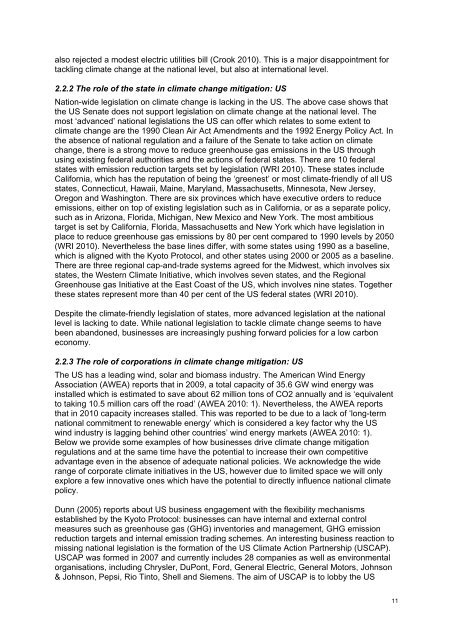IDS WORKING PAPER - Institute of Development Studies
IDS WORKING PAPER - Institute of Development Studies
IDS WORKING PAPER - Institute of Development Studies
You also want an ePaper? Increase the reach of your titles
YUMPU automatically turns print PDFs into web optimized ePapers that Google loves.
also rejected a modest electric utilities bill (Crook 2010). This is a major disappointment for<br />
tackling climate change at the national level, but also at international level.<br />
2.2.2 The role <strong>of</strong> the state in climate change mitigation: US<br />
Nation-wide legislation on climate change is lacking in the US. The above case shows that<br />
the US Senate does not support legislation on climate change at the national level. The<br />
most ‘advanced’ national legislations the US can <strong>of</strong>fer which relates to some extent to<br />
climate change are the 1990 Clean Air Act Amendments and the 1992 Energy Policy Act. In<br />
the absence <strong>of</strong> national regulation and a failure <strong>of</strong> the Senate to take action on climate<br />
change, there is a strong move to reduce greenhouse gas emissions in the US through<br />
using existing federal authorities and the actions <strong>of</strong> federal states. There are 10 federal<br />
states with emission reduction targets set by legislation (WRI 2010). These states include<br />
California, which has the reputation <strong>of</strong> being the ‘greenest’ or most climate-friendly <strong>of</strong> all US<br />
states, Connecticut, Hawaii, Maine, Maryland, Massachusetts, Minnesota, New Jersey,<br />
Oregon and Washington. There are six provinces which have executive orders to reduce<br />
emissions, either on top <strong>of</strong> existing legislation such as in California, or as a separate policy,<br />
such as in Arizona, Florida, Michigan, New Mexico and New York. The most ambitious<br />
target is set by California, Florida, Massachusetts and New York which have legislation in<br />
place to reduce greenhouse gas emissions by 80 per cent compared to 1990 levels by 2050<br />
(WRI 2010). Nevertheless the base lines differ, with some states using 1990 as a baseline,<br />
which is aligned with the Kyoto Protocol, and other states using 2000 or 2005 as a baseline.<br />
There are three regional cap-and-trade systems agreed for the Midwest, which involves six<br />
states, the Western Climate Initiative, which involves seven states, and the Regional<br />
Greenhouse gas Initiative at the East Coast <strong>of</strong> the US, which involves nine states. Together<br />
these states represent more than 40 per cent <strong>of</strong> the US federal states (WRI 2010).<br />
Despite the climate-friendly legislation <strong>of</strong> states, more advanced legislation at the national<br />
level is lacking to date. While national legislation to tackle climate change seems to have<br />
been abandoned, businesses are increasingly pushing forward policies for a low carbon<br />
economy.<br />
2.2.3 The role <strong>of</strong> corporations in climate change mitigation: US<br />
The US has a leading wind, solar and biomass industry. The American Wind Energy<br />
Association (AWEA) reports that in 2009, a total capacity <strong>of</strong> 35.6 GW wind energy was<br />
installed which is estimated to save about 62 million tons <strong>of</strong> CO2 annually and is ‘equivalent<br />
to taking 10.5 million cars <strong>of</strong>f the road’ (AWEA 2010: 1). Nevertheless, the AWEA reports<br />
that in 2010 capacity increases stalled. This was reported to be due to a lack <strong>of</strong> ‘long-term<br />
national commitment to renewable energy’ which is considered a key factor why the US<br />
wind industry is lagging behind other countries’ wind energy markets (AWEA 2010: 1).<br />
Below we provide some examples <strong>of</strong> how businesses drive climate change mitigation<br />
regulations and at the same time have the potential to increase their own competitive<br />
advantage even in the absence <strong>of</strong> adequate national policies. We acknowledge the wide<br />
range <strong>of</strong> corporate climate initiatives in the US, however due to limited space we will only<br />
explore a few innovative ones which have the potential to directly influence national climate<br />
policy.<br />
Dunn (2005) reports about US business engagement with the flexibility mechanisms<br />
established by the Kyoto Protocol: businesses can have internal and external control<br />
measures such as greenhouse gas (GHG) inventories and management, GHG emission<br />
reduction targets and internal emission trading schemes. An interesting business reaction to<br />
missing national legislation is the formation <strong>of</strong> the US Climate Action Partnership (USCAP).<br />
USCAP was formed in 2007 and currently includes 28 companies as well as environmental<br />
organisations, including Chrysler, DuPont, Ford, General Electric, General Motors, Johnson<br />
& Johnson, Pepsi, Rio Tinto, Shell and Siemens. The aim <strong>of</strong> USCAP is to lobby the US<br />
11

















